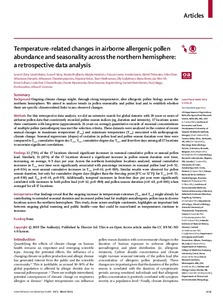Temperature-related changes in airborne allergenic pollen abundance and seasonality across the northern hemisphere: a retrospective data analysis
Ziska L.H.; Makra L.; Harry S.K.; Bruffaerts N.; Hendrickx M.; Coates F.; Saarto A.; Thibaudon M.; Oliver G.; Damialis A.; Charalampopoulos A.; Vokou D.; Heiđmarsson S.; Guđjohnsen E.; Bonini M.; Oh J.-W.; Sullivan K.; Ford L.; Brooks G.D.; Myszkowska D.; Severova E.; Gehrig R.; Ramón G.D.; Beggs P.J.; Knowlton K.; Crimmins A.R.
https://urn.fi/URN:NBN:fi-fe2021042826794
Tiivistelmä
Background: Ongoing climate change might, through rising temperatures, alter allergenic pollen biology across the northern hemisphere. We aimed to analyse trends in pollen seasonality and pollen load and to establish whether there are specific climate-related links to any observed changes.
Methods: For this retrospective data analysis, we did an extensive search for global datasets with 20 years or more of airborne pollen data that consistently recorded pollen season indices (eg, duration and intensity). 17 locations across three continents with long-term (approximately 26 years on average) quantitative records of seasonal concentrations of multiple pollen (aeroallergen) taxa met the selection criteria. These datasets were analysed in the context of recent annual changes in maximum temperature (Tmax) and minimum temperature (Tmin) associated with anthropogenic climate change. Seasonal regressions (slopes) of variation in pollen load and pollen season duration over time were compared to Tmax, cumulative degree day Tmax, Tmin, cumulative degree day Tmin, and frost-free days among all 17 locations to ascertain significant correlations.
Findings: 12 (71%) of the 17 locations showed significant increases in seasonal cumulative pollen or annual pollen load. Similarly, 11 (65%) of the 17 locations showed a significant increase in pollen season duration over time, increasing, on average, 0·9 days per year. Across the northern hemisphere locations analysed, annual cumulative increases in Tmax over time were significantly associated with percentage increases in seasonal pollen load (r=0·52, p=0·034) as were annual cumulative increases in Tmin (r=0·61, p=0·010). Similar results were observed for pollen season duration, but only for cumulative degree days (higher than the freezing point [0°C or 32°F]) for Tmax (r=0·53, p=0·030) and Tmin (r=0·48, p=0·05). Additionally, temporal increases in frost-free days per year were significantly correlated with increases in both pollen load (r=0·62, p=0·008) and pollen season duration (r=0·68, p=0·003) when averaged for all 17 locations.
Interpretation: Our findings reveal that the ongoing increase in temperature extremes (Tmin and Tmax) might already be contributing to extended seasonal duration and increased pollen load for multiple aeroallergenic pollen taxa in diverse locations across the northern hemisphere. This study, done across multiple continents, highlights an important link between ongoing global warming and public health—one that could be exacerbated as temperatures continue to increase.
Kokoelmat
- Rinnakkaistallenteet [27094]
